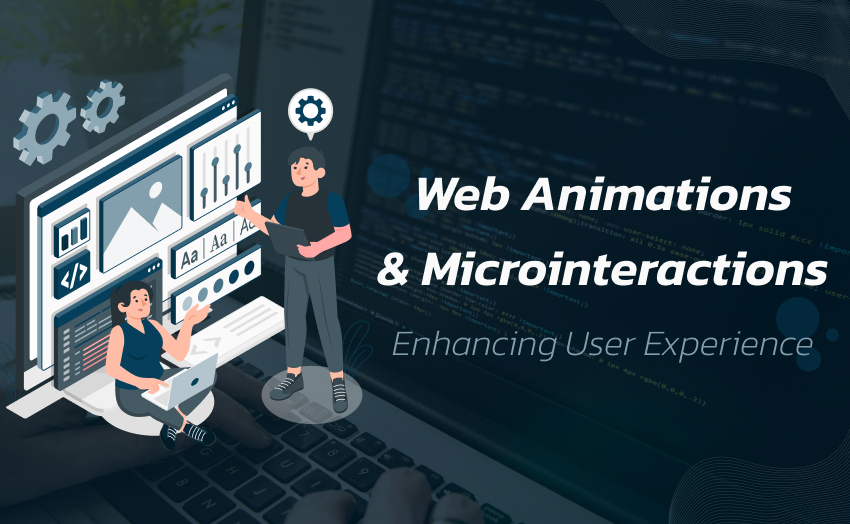User experience is crucial in today’s digital environment, and web animations and microinteractions are among the best ways to improve it. These design components give websites more life and interactivity, helping to engage users, convey key messages, and enhance a site’s overall usability. Whether you’re creating a straightforward landing page or a sophisticated web application, adding thoughtful animations and microinteractions can have a big impact on how users view and use your website.
At Niotechone Software Pvt. Ltd., we understand the importance of delivering exceptional digital experiences. By incorporating cutting-edge animations and intuitive microinteractions into our projects, we help businesses create engaging, user-friendly websites and applications that leave a lasting impression.
What are Web Animations?
Web animations consist of dynamic, moving components that serve to visually captivate users and improve the user interface (UI). These animations can vary from basic effects, such as hover states, to more intricate animations, including page transitions and animated loading indicators. The implementation of web animations can be achieved through CSS, JavaScript, or a combination of both.
Animations enhance visual engagement, direct users’ focus to particular sections, and contribute to a more intuitive user experience. For example, an animated button can indicate its clickability, while transitions between pages can facilitate a more seamless navigation experience.
Some common types of web animations include:
- Page Transitions: Smooth transitions between pages or sections that provide continuity and reduce the perception of page reloads.
- Loading Animations: Spinners, progress bars, and other animations that inform users that content is loading, helping to alleviate frustration during waiting times.
- Hover Effects: Subtle animations that activate when a user hovers over a UI element, like a button or a link, to indicate interactivity.
- Scroll Animations: Animations that trigger when the user scrolls down the page, often used to reveal content or provide visual feedback as users progress through the page.
What are Microinteractions?
Microinteractions refer to the minor, nuanced animations or design elements that influence user behavior and affirm actions within a website or application. Each microinteraction is generally designed for a specific function, such as delivering feedback, signaling status, or directing the user on subsequent actions. Although frequently underestimated, these interactions are essential for enhancing the overall user experience.
These interactions are triggered by user activities, including clicking, swiping, or typing, and they offer visual feedback. By making the interface appear more responsive and engaging, microinteractions contribute to a more immersive and intuitive user experience.
Key Elements of Microinteractions
Microinteractions can be broken down into four key elements:
- Trigger: The action that initiates the microinteraction, such as a user clicking a button, filling in a form field, or even scrolling.
- Rules: The behavior or function that dictates how the microinteraction will unfold. For example, what happens after a user clicks a button or swipes a card?
- Feedback: Visual, auditory, or haptic signals that inform the user about the result of their action. For instance, a button changing color when clicked or a success message after submitting a form.
- Duration: The length of time the microinteraction lasts, which should be short enough to feel seamless yet long enough to communicate the feedback clearly.
Examples of microinteractions include:
- Button Clicks: When a user clicks on a button, it could change color, scale, or animate to indicate that the action was successfully registered.
- Form Field Validations: A small animation or color change that appears when a user enters valid or invalid data in a form field.
- Like Button Animations: The “like” button on social media sites that animates when clicked, providing feedback that the action has been successfully completed.
- Hover Effects: A subtle scale or color shift on hover that provides feedback to users about interactive elements.
Why Web Animations and Microinteractions Matter
Both web animations and microinteractions help make websites feel more human, guiding users through the experience while making interactions more enjoyable. Here are several reasons why they are important:
1. Improved User Experience
Animations and microinteractions help users understand how to interact with the site. For example, a hover effect on a button or link clearly indicates that it is clickable. Microinteractions also help prevent users from feeling lost by providing real-time feedback when actions are taken, such as submitting a form or toggling a setting.
2. Enhancing Usability
Subtle animations can improve usability by visually guiding users and reinforcing their actions. For instance, when a user presses a “Save” button, an animation can confirm that the data has been successfully saved. This makes the process more intuitive and satisfying.
3. Delighting Users
Animations and microinteractions can bring a sense of delight and surprise, enhancing the emotional connection between users and a website. When used thoughtfully, they can add a playful touch that makes the site memorable and enjoyable to use.
4. Creating Brand Identity
Animations and microinteractions can reflect a brand’s personality. Whether it’s a sleek, professional transition or a fun, whimsical effect, these design elements can reinforce brand identity. For example, a website for a design agency may use subtle animations to convey creativity and innovation.
5. Improved Engagement
Microinteractions and animations can increase user engagement by making the interface more interactive and responsive. When users feel that their actions have an immediate and visible effect, they are more likely to continue interacting with the site. For instance, feedback animations can increase the likelihood of users completing forms or participating in calls to action.
Best Practices for Using Animations and Microinteractions
To make the most of animations and microinteractions, it’s essential to follow best practices to ensure they enhance the user experience rather than distract from it:
- Be Subtle: Overuse of animations can overwhelm the user and reduce their effectiveness. Subtle, minimalistic animations are often more impactful than loud, flashy ones.
- Keep it Purposeful: Every animation and microinteraction should have a clear purpose, such as guiding the user or providing feedback. Avoid unnecessary animations that do not contribute to the experience.
- Optimize for Performance: Poorly optimized animations can slow down page load times, which harms the user experience. Use efficient animation techniques and ensure that they are smooth across devices and screen sizes.
- Respect User Preferences: Some users may prefer reduced motion for accessibility reasons. Provide an option to disable animations or adjust motion settings based on user preferences.
- Maintain Consistency: Consistency in animation timing, feedback, and behavior is key to ensuring that users don’t become confused or frustrated. Establish a clear animation style and stick to it throughout the site.
Conclusion
Web animations and microinteractions serve as effective instruments for developing captivating and user-centric websites. Thoughtful design of these components can enhance user experience, offer immediate feedback, facilitate navigation, and infuse character into your site. Regardless of whether you are crafting a straightforward webpage or a sophisticated application, incorporating animations and microinteractions can significantly influence user interaction with your product, resulting in improved engagement and overall satisfaction.



